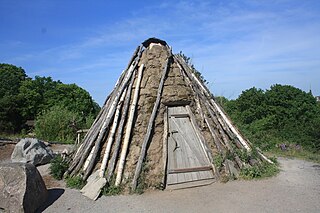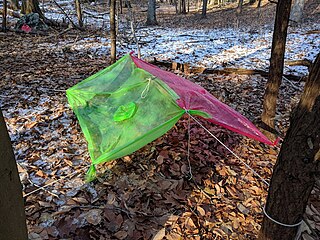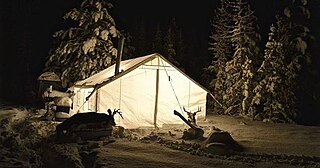 W
WA tent is a shelter consisting of sheets of fabric or other material draped over, attached to a frame of poles or attached to a supporting rope. While smaller tents may be free-standing or attached to the ground, large tents are usually anchored using guy ropes tied to stakes or tent pegs. First used as portable homes by nomads, tents are now more often used for recreational camping and as temporary shelters.
 W
WA bell tent is a human shelter for inhabiting, traveling or leisure that has been used since 600AD. The design is a simple structure, supported by a single central pole, covered with cotton canvas. The stability of the tent is reinforced with tension by guy ropes connected around the top of the walls and being held down by pegs around the circumference to the ground. It has a circular floor plan of some 10 ft and larger. The multiple sizes of bell tents can be suited to their use or preference and most have a spacious interior, with room to sleep a number of people.
 W
WA chum is a temporary dwelling used by the nomadic Uralic reindeer herders of northwestern Siberia of Russia. The Evenks, Tungusic peoples, tribes, in Russia, Mongolia and China also use chums. They are also used by the southernmost reindeer herders, of the Todzha region of the Republic of Tyva and their cross-border relatives in northern Mongolia. It has a design similar to a Native American tipi but some versions are less vertical. It is very closely related to the Sami lavvu in construction, but is somewhat larger in size. Some chums can be up to thirty feet in diameter.
 W
WA fly refers to the outer layer of a tent or to a piece of material which is strung up using rope as a minimalist, stand-alone shelter. In basic terms, a fly is a tent without walls. Purpose-made stand-alone flies are also sometimes referred to as bivouacs, bivvies, tarpaulins, or hootchies. Flies are generally used for keeping moisture or sun off people while they eat, rest or sleep. They can also be used as groundsheets, but this is not recommended since it creates wear and tear which can lead to holes.
 W
WGeneral George Washington used a pair of campaign tents (marquees) throughout much of the American Revolutionary War. In warm weather, he used one for dining with his officers and aides, and the other as his military office and sleeping quarters. Canvas panels and poles from both tents survive, and are currently owned by four separate historical organizations.
 W
WA goahti, goahte, gåhte, gåhtie or gåetie, ,, is a Sami hut or tent of three types of covering: fabric, peat moss or timber. The fabric-covered goahti looks very similar to a Sami lavvu, but often constructed slightly larger. In its tent version the goahti is also called a 'curved pole' lavvu, or a 'bread box' lavvu as the shape is more elongated while the lavvu is in a circular shape.
 W
WThe Kohte [ˈkoːtə] is the typical tent of German Scouting and the German Youth Movement. It has several unusual features, including its distinctive black colour and its design to allow a central fire.
 W
WOriginally, half of a Finnish conical tent called a laavu, the contemporary loue, redesigned by brands such as Finnrover and Vihe Vaellus, is an ultra-light Finnish open tent-like shelter. It is used to give reasonable protection from wind and rain during a variety of outdoor adventures, including camping, canoeing, hiking and hunting. Loues are popular with Scout groups and minimalist campers. Suitable as one or two person shelters, they are compact, light and can be set up and taken down in a basic way fairly quickly. The workman-like sets shown in photographs indicate that more effort can be made to stiffen the sides and the stakes and lines used can complicate a taut setup. The open front permits fire viewing, ventilation and looking out over a scenic view. A loue consists of a roughly conical section of fabric with the semi-circular bottom edge grounded by stakes and the tip raised with a single pole. Suitable standing tree trunks may be used to suspend the tent if an open campfire is not to be used. This style of ''tarp tent" can best be raised using a scissors-pole assembly. A pole suspension system allows for positioning an open fire in front of the shelter without the risk of damaging tree trunks or roots. The panels of a true Finnish loue are designed to provide a semi-circular short wall around the shelter and a triangular piece at the tip can be let down to provide a little more shelter in front. With suitable siting and careful staking and tensioning, the side walls can be set close to the ground, providing protection from drafts and lifting from winds.
 W
WA Whymper tent is a ridge tent of A-frame construction used for mountaineering which was designed by English mountaineer Edward Whymper (1840–1911) and named after him. Whymper was the first person to ascend the Matterhorn. Tents using his general design were in common use from the later part of the nineteenth century to the mid-twentieth century and were referred to generically as "Whymper tents". A later smaller variant of the design was called the Meade tent.
 W
WThe Modular Command Post System (MCPS) is a modular tent system for mobile or temporary tactical operations centers developed in the early-mid 1990s by the United States Army. The tents are designed to be utilised as a free-standing shelter, or when used with a bootwall, attached to other types of U.S. Army shelters and tactical vehicles such as variants of the HMMWV (Humvee).
 W
WA Mummery tent is a small, lightweight tent designed and used by Albert Frederick Mummery in the 1880s and named after him. Fred Mummery (1855–1895) was an English pioneer in alpine climbing, making many first ascents, and he developed this type of tent for his lightweight expeditions.
 W
WThere are a series of tents at the Oktoberfest, which are operated by different Wiesn-hosts and in which some come from a long tradition. Some tents belong to the local breweries. The setup work for the tents often begins three months before the start of the festival.
 W
WA poncho tent is a type of improvised emergency shelter, constructed using a rain poncho. Using materials on hand that were intended for use as rain gear, it becomes possible to re-purpose them as a shelter.
 W
WA Ramadan tent is a venue erected during the month of Ramadan for people to eat the daily Iftar meal. They are common across the Middle East and can be found anywhere there are communities of Muslims. Ramadan tents provide a place for people to meet with friends and family after the daily fast is broken at sunset. People gather there to eat Iftar, drink tea, and smoke shisha. Ramadan tents are traditionally a family or neighborhood affair in the Middle East. A Jordanian journalist described a typical Ramadan tent thus in 2008:Under the fluffy colorful ceiling of the big tent, you can treat yourself and friends to various types of sweets, entertainment and distraction until the very early hours of the morning, while playing game after game of cards. A musical band with a leading singer can play classical pieces of Arab music. ... Waiters are dressed in special 19th- or 18th-century attire with the red cylinder-shaped hat better known as "tarboush." They offer you, in addition to the very popular argeelah, a rich assortment of little snacks.
 W
WA roof tent is an accessory which may be fitted to the roof of a motor vehicle which allows the users to sleep in relative safety and comfort above the vehicle, and leaves the internal load-space free. The first example of roof-tents appeared in Western Europe in the 1930s.
 W
WThe Sibley tent was invented by the American military officer Henry Hopkins Sibley and patented in 1856. Of conical design, it stands about 12 feet (3.7 m) high and 18 feet (5.5 m) in diameter. It can comfortably house about a dozen men.
 W
WA spiegeltent is a large travelling tent, constructed from wood and canvas and decorated with mirrors and stained glass, intended as an entertainment venue. Originally built in Belgium during the late 19th and early 20th centuries, only a handful of these spiegeltents remain in existence today, and these survivors continue to travel around Europe and beyond, often as a feature attraction at various international arts festivals. Two tents used by Teatro ZinZanni have been in fixed locations in Seattle and San Francisco for several years. The Melba Spiegeltent spent the better part of a century touring Europe, but is now permanently located in Melbourne, Australia. The Famous Spiegeltent, built in 1920, was first used in the Adelaide Fringe in 2000 and is now owned by an Australian jazz piano player David Bates.
 W
WIn Australia, a swag is a portable sleeping unit. It is normally a bundle of belongings rolled in a traditional fashion to be carried by a foot traveller in the bush. Before motor transport was common, foot travel over long distances was essential to agriculture in the Australian bush. It is sometimes referred to as a "backpack bed". Swags have been carried by shearers, miners, the unemployed, and many others, some of whom would have been happy to have been called swagmen and some not.
 W
WA tarp tent is a tarpaulin, a plastic or nylon sheet, used in place of a tent. It is usually rigged with poles, tent pegs, and guy lines. Ultralight backpackers use tarp tents because they are lightweight compared to other backpacking shelters.
 W
WA tent peg is a spike, usually with a hook or hole on the top end, typically made from wood, metal, plastic, or composite material, pushed or driven into the ground for holding a tent to the ground, either directly by attaching to the tent's material, or by connecting to ropes attached to the tent. Traditionally, a tent peg is improvised from a section of a small tree branch, if possible with a small side branch cut off to leave a hook, driven into the ground narrower end first.
 W
WA tent platform is a floor for the purpose of pitching one or more tents upon. Typically, it is a wooden deck near a hiking trail that provides the hikers a clean and even place to sleep. It may also prevent the campers from trampling down the surrounding vegetation. Many campsites have tent platforms. Mountaineers sometimes build tent platforms in their base camps from materials such as pebble or snow.
 W
WA tipi, also tepee or teepee and often called a lodge in older English writings, is a tent, traditionally made of animal skins upon wooden poles. Modern tipis usually have a canvas covering. A tipi is distinguished from other conical tents by the smoke flaps at the top of the structure.
 W
WThe tupiq is a traditional Inuit tent made from seal or caribou skin. Inuit must kill 5 to 10 ugjuk to make a sealskin tent. If a man goes hunting for four to five, he would bring a small tent made out of five ugjuit. A family tent would be made of ten or more ugjuit.
 W
WThe tupiq is a traditional Inuit tent made from seal or caribou skin. Inuit must kill 5 to 10 ugjuk to make a sealskin tent. If a man goes hunting for four to five, he would bring a small tent made out of five ugjuit. A family tent would be made of ten or more ugjuit.
 W
WA wall tent, also known as an outfitter tent, safari tent, or sheep herder tent is a type of tent that has four straight vertical walls that provide more headroom than traditional pyramid-shaped tents. Wall tents are typically made of a heavy canvas and are used by hunters because they can accommodate several people and their supplies. Wall tents are suitable as a four-season tent, as they are able to accommodate a wood stove. Wall tents are commonly used in Civil War reenactments, and, in recent years, have also become used for glamping. Frames may be either internal or external. Tents are light weight yet sturdy. They are easy to carry & not too difficult when it comes to setting them up.
 W
WA Whymper tent is a ridge tent of A-frame construction used for mountaineering which was designed by English mountaineer Edward Whymper (1840–1911) and named after him. Whymper was the first person to ascend the Matterhorn. Tents using his general design were in common use from the later part of the nineteenth century to the mid-twentieth century and were referred to generically as "Whymper tents". A later smaller variant of the design was called the Meade tent.
 W
WA Yaranga is a tent-like traditional mobile home of some nomadic Northern indigenous peoples of Russia, such as Chukchi and Siberian Yupik.
 W
WA traditional yurt or ger (Mongolian) is a portable, round tent covered with skins or felt and used as a dwelling by several distinct nomadic groups in the steppes of Central Asia. The structure consists of an angled assembly or latticework of wood or bamboo for walls, a door frame, ribs, and a wheel possibly steam-bent. The roof structure is often self-supporting, but large yurts may have interior posts supporting the crown. The top of the wall of self-supporting yurts is prevented from spreading by means of a tension band which opposes the force of the roof ribs. Modern yurts may be permanently built on a wooden platform; they may use modern materials such as steam-bent wooden framing or metal framing, canvas or tarpaulin, plexiglass dome, wire rope, or radiant insulation.